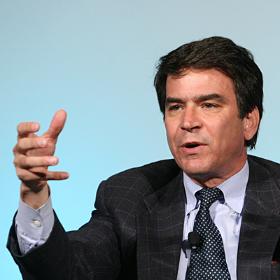Verklin Shares Canoe Ventures' Objectives, Business Models and Challenges

Canoe Ventures, the joint initiative of six major cable system operators, is focused on three primary objectives, advises CEO David Verklin.
1. Allow advertisers to interact directly with television consumers.
2. Generate incremental revenue streams for programming networks by enabling new forms of inventory, such as polling/voting and 'requests for information.'
3. Turn set-top box data into currencies for advanced TV applications.
In a wide ranging exclusive interview with Jack MyersMedia Business Report, Verklin outlined his vision for the future of Canoe Ventures and interactive television, suggested that partnerships/relationships with Google, Microsoft and TiVo could be on the horizon, argued that a TV media buying/selling exchange is a natural outgrowth of addressability, and explained why there will be a creative renaissance for commercial creation.
In the aggregate, Verklin explains that Canoe will enable TV networks to both enhance and define the value of commercial inventory. "We are focusing on all forms of new revenue models for our partners," Verklin commented. In addition to new products that Verklin expects to roll-out within the next 12-months, he anticipates several new research and analytic services and "is excited about creating ways for others to make money. We have a vision for a renaissance of commercial creation and of opening television for completely new advertiser categories."
Within the next 120 days, Verklin says Canoe will release its first product, a creative versioning tool that will enable cable TV networks to divide national inventory into demographic footprints. Canoe has overlaid census data on 2,200 cable systems, 1,200 of which have more than 10,000 households. Working with Experian, geography has been converted to demography, enabling Canoe to provide networks with the ability to run different commercials in demographically homogeneous homes. For example, says Verklin, a financial services company can target one message to high income homes, another to mid-income homes, and a third to lower income households. Verklin wondered aloud about the prospects of a marketer running a Spanish-language commercial in certain neighborhoods, even though it would also run in some English-speaking homes. The next product to be rolled-out will be a similar product for broadcast networks, followed by the ability for networks to sell the same unit to multiple advertisers, divided by their target demographic universes.
"These are rudimentary offerings," Verklin acknowledges. "They represent the first steps. The ultimate promise is addressability -- to put dog food commercials only into homes with dogs." He draws an analogy to a lumber mill. "A lumber mill used to have a single fixed saw blade, leaving a lot of wasted wood. Today, when a log comes in at one end, a computer analyzes the log and adjusts multiple saw blades that maximize the value of each log. A log is comparable to a linear :30-second commercial. The computer is programmed to use set-top data to maximize the delivery of messages to households, carving out audience segments. The only thing a pig farmer doesn't sell," Verklin laughs, "is the oink."
But the reality of addressability is complex and while there are companies currently developing systems to manage cable set-top data and create actionable business models, Verklin perceives Canoe as an "enabler" that will work with media buyers and sellers. "You need the computer to manage all the pieces," he points out, and "you can't have addressability without a [buying/selling] exchange. An exchange and ad serving model for television is a natural outgrowth of addressability. An auction model finds the right pricing level for the multiple media segments that will become available."
In Verklin's future vision, seven of the current 14 to 16 minutes per hour of national commercial time will be sold nationally, as they are currently. The remaining seven to nine minutes of networks' commercial time will be enhanced with interactive "collars" and addressability. Verklin envisions voting and polling as the first of these applications that Canoe will offer, along with enabling viewer requests for more information.
Verklin's team is meeting daily with a diverse spectrum of companies to explore additional capabilities designed to generate incremental revenues for networks and cable operators. Canoe is spending significant time working with the technology leaders at the six participating cable system operators, which include Time Warner, Comcast, Cox, Charter, Cablevisionand Bright House. A two-pronged sales and support organization is being formed, one group to work with sales organizations and another, headed by former Carat executive Bruce Dennler, to work with agency organizations.
In September 1999, Verklin, who joined Canoe Ventures this year after a decade as CEO of Aegis Media AmericasandCarat USA, delivered a keynote address to 600 executives at the first Jack MyersForum on Interactive TV Development and suggested "the American advertising industry is structurally unprepared for an age where Interactive TV commercials go on the air." He suggested that "media and creative will certainly become more equal partners in the industry revolution. From a media sellers perspective our research is indicating that the selling models will have some component of the cost per air time, like now, but also incremental revenue if the media deliver sales leads and interaction. There will be two revenue streams, two ways to make money. From the buying perspective, the model that we see will have greater levels of media accountability. We will know if something is working; we will know if something is underperforming."
Verklin, an outspoken advocate for interactive television expansion since the mid-1990s, is now at the helm of the industry's most ambitious effort to bring iTV to the reality he envisioned more than a decade ago.


